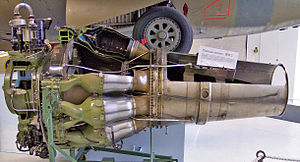- de Havilland Ghost
-
Ghost A Swedish licensed-built de Havilland Ghost, the RM 2 Type Turbojet Manufacturer de Havilland Engine Company First run 2 September 1945 Major applications de Havilland Comet
de Havilland Venom
de Havilland Sea VenomDeveloped from de Havilland Goblin The de Havilland Ghost (originally Halford H-2) was the de Havilland Engine Company's second turbojet engine design to enter production and the world's first gas turbine engine to enter airline (BOAC) service. A scaled up development of the Goblin, the Ghost powered the de Havilland Venom, de Havilland Comet and SAAB Tunnan.[1]
Contents
Design and development
The Ghost came about when de Havilland started work on what was to become the Comet in 1943. Frank Halford's first design, the H-1, was just entering production and he was able to meet the power requirements of the Comet by simply scaling up features of the H-1. The resulting H-2 also used ten larger flame cans in place of the Goblin's sixteen smaller ones, using "split intakes" to each can to feed in more air, as if there were twenty cans feeding off the compressor. While the prototype was being built, de Havilland bought Halford's firm and reformed it as the de Havilland Engine Company, renaming the H-1 and H-2 as the Goblin and Ghost respectively.
The Ghost was already being tested in 1944, and flew in 1945. This was long before the Comet or Venom was ready for flight. By this point the Ghost had been selected for the Swedish "JxR" fighter project, which eventually turned into the Tunnan. During the design of the Tunnan, Sweden received German data on swept wing designs via Switzerland and redesiged the plane to incorporate this planform. The Tunnan first flew in this form in 1948. For production versions of the Tunnan, the Ghost was built under licence by Svenska Flygmotor (later to become Volvo Aero) as the RM2.
The Ghost would next be seen when the Comet finally took to the air on 27 July 1949. This prototype was powered by the 5,000 lbf (22 kN) Ghost 50, although this was an interim measure while more powerful engines could be developed. The "real" version of the aircraft would be the Rolls-Royce Avon-powered Comet 2, but these engines were not yet ready for flight. In order to make up for the low thrust of the Ghost, the Comet was lightened by using thin-gauge skinning. It was this thin skin that was later found to be a contribution to the cause of a number of infamous crashes, due to metal fatigue. Several versions of the Ghost 50 were produced, ending with the Ghost 50-Mk.4 mounted on the Comet 1XB that was built to test new fuselage construction techniques to address the problems in the Comet 1.
During development, the Royal Air Force also asked for an improved version of the de Havilland Vampire with greater load carrying capacity and thus a larger engine. The resulting design was known as the Venom, and shared many features with the earlier Vampire. The Ghost first flew in the Venom on 2 September 1949. By this point the engine had been running for some time and was already at the Mk.103 model of 4,850 lbf (21,600 N). The Venom was used primarily as a fighter bomber, although some were also produced as night fighters. The Venom was later selected by the Fleet Air Arm for their interceptor needs, and was widely used as the Sea Venom.
Variants
- Ghost 45, rated at 4,400 lbf (19.7 kN)
- Ghost 48, rated at 4,850 lbf (21.6 kN)
- Ghost 50 Mk 1, rated at 5,000 lbf (22.2 kN) at 10,000 rpm with a weight of 2,011 lb (912 kg) (1)
- Ghost 50 Mk 2, rated at 5,125 lbf (22.8 kN)
- Ghost 103, rated at 4,850 lbf (21.6 kN)
- Ghost 104, rated at 4,950 lbf (22.0 kN)
- Ghost 105, rated at 5,150 lbf (22.9 kN)
Applications
- de Havilland Comet
- de Havilland Venom
- de Havilland Sea Venom
- "Ghost-Lancastrian"
- Saab Tunnan
- Crusader (speedboat)
Specifications (Ghost 50)
General characteristics
- Type: Turbojet
- Length: 121 in
- Diameter: 53 in
- Dry weight: 2,218 lb
Components
- Compressor: Single stage centrifugal flow
- Combustors: 10 chambers
- Turbine: Single-stage
- Fuel type: Kerosene
Performance
- Maximum thrust: 5,000 lbf at 10,250 rpm
- Overall pressure ratio: 4.6
- Specific fuel consumption: 1.02 lb/hr/lbf
- Power-to-weight ratio:
See also
- Related development
- Related lists
References
Notes
- ^ Gunston 1989, p.52.
Bibliography
- Gunston, Bill. World Encyclopedia of Aero Engines. Cambridge, England. Patrick Stephens Limited, 1989. ISBN 1-85260-163-9
- Smith, Geoffrey G.Gas Turbines and Jet Propulsion for Aircraft, London S.E.1, Flight Publishing Co.Ltd., 1946.
External links
de Havilland aero engines Piston engines Ghost · Gipsy · Gipsy Junior · Gipsy Minor · Gipsy Major · Gipsy Six · Gipsy Queen · Gipsy Twelve · Gipsy King · Iris
Turbojet Ghost · Goblin · Gyron · Gyron Junior
Turboprop/turboshaft Rocket Designers Svenska Flygmotor/Volvo Flygmotor/Volvo Aero aeroengines Reciprocating engines B42 · B44
Turbojets Turbofans RM8 · RM12
Swedish military gas turbine aircraft engine designation system Lists relating to aviation General Aircraft (manufacturers) · Aircraft engines (manufacturers) · Airlines (defunct) · Airports · Civil authorities · Museums · Registration prefixes · Rotorcraft (manufacturers) · TimelineMilitary Accidents/incidents Records Categories:- De Havilland aircraft engines
- Turbojet engines 1940-1949
Wikimedia Foundation. 2010.

